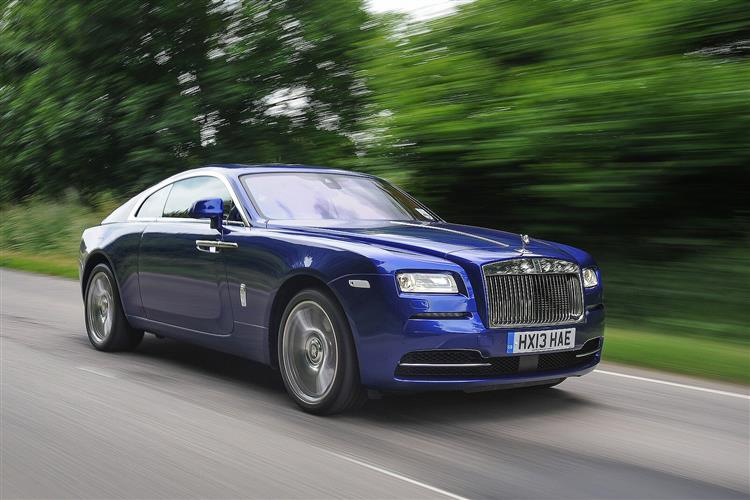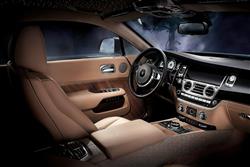SHOULD YOU HAVE FAITH IN A WRAITH? (some text hidden) --NONE--
By Jonathan Crouch
Introductionword count: 58
Back in 2013, the Wraith was the most powerful car Rolls Royce had ever made - and perhaps the closest thing to a sportscar we'd ever seen from the brand. Based on the marque's Ghost entry-level saloon, there's nothing else quite like this British-made luxury Grand Touring coupe - nor should there be for the exalted asking price.
Modelsword count: 6
4dr Luxury Coupe (6.6-litre V12 petrol)
Historyword count: 314
The last time the Wraith badge was solely used on a model bearing the Spirit of Ecstasy on its bonnet was way back in 1938 when the car in question would have cost its then owner a princely £1,700. Since then, Rolls Royce occasionally referenced the name - with the Silver Wraith of 1946 and the Silver Wraith II of 1977 - but never really committed itself to reviving it. Something else the brand never really committed itself to reviving - until the launch of this modern-era Wraith coupe - was its sporting heritage. You might be surprised to hear that the company has any but in fact, founder Charles Rolls won the Isle of Man Tourist Trophy in 1906 in a Light Twenty model, while in 1913, Don Carlos de Salamanca won the first ever Spanish Grand Prix in a Silver Ghost. Launched in 2013, the Wraith of course wasn't intended as the base for any kind of modern competition onslaught, but it was an important tool that was intended to enable the company to do something much more important - namely to appeal to a younger audience of buyers. In today's world, vast wealth is no longer restricted to those approaching retirement age and if you happen to have acquired unrestricted means, desire something exotic and exclusive and don't want either a chauffeur or an uncomfortable supercar, then your choices are rather few. It was to such a person that this so-called 'debonair gentleman's GT' aimed to appeal, a bold statement of individuality and a Rolls Royce unlike any we had seen before. The kind of car, we're told, that Charles Rolls would have chosen to drive. More exclusive 'Black Badge' versions were launched in 2016 and production finished in 2023 with a limited edition 'Black Badge Wraith Black Arrow' version. Let's see if a Wraith makes sense as a used buy.
What You Getword count: 728
'There's a sense of effortless grace and elegance about this car - but at the same time, something more contemporary and daring'. The words are from Giles Taylor, who back in 2013 was Rolls Royce's Director of Design. Yes, the Wrath was effectively a two-door version of the company's Ghost saloon, itself based upon the humbler underpinnings of a BMW 7 Series - but to dismiss the car in that fashion would be to misunderstand much of the care the company lavished upon it. This certainly doesn't look like a Ghost coupe, but then that's partly because it was fundamentally re-engineered for its more sporting role in life, with a wheelbase 183mm shorter, a rear axle track stretched by 24mm and a roofline brought 50mm closer to the ground. There's also the little matter of the extra 61bhp being developed by the twin turbo 6.6-litre V12 beneath the bonnet. That engine, like this car's platform, was sourced from BMW. Do those things make it any less of a Rolls Royce? We think not. What makes this Wraith worthy of its Spirit of Ecstasy bonnet mascot (sculptor Charles Sykes' tribute to his mistress, Eleanor Thornton) is the exquisite detail that underpins everything about it. Even that mascot is aerodynamic, canted back a few degrees more than it would be in the saloon model to give the impression of speed. The familiar front pantheon grille was also recessed for the Wraith, giving a less prominent prow to the vast bonnet. Under the skin of the all-steel body, the depth of engineering goes even further, with most of the panels brazed by hand before the joins are sanded to a perfect finish for painting. There are over 6,000 spot welds on the car and laser-welded seams in places such as a sculpted rear section. Rolls-Royce also fitted a double front bulkhead to keep the cabin extra-quiet. In other words, anyone who thinks this is merely a 7 Series in a posh frock really has no idea what they're talking about. We're not sure though, that the substantial shape works from all angles. The profile's certainly purposeful, with larger 20-inch wheels than you'd find on a Ghost working well with the high waistline. From a rear three-quarter view though, you really sense the stylistic weight of enormous C-pillars that flow into an expensively brazed panel, there to blend beautifully with the optional two-tone paint finish. Entry, as usual with a modern Rolls Royce, is via a vault-like coach door, unusual in the way it aids access by hinging at the back rather than the front. You expect it to weigh a tonne but pull the polished steel handle and there's a lightness and balance to the opening action that just speaks of brilliant engineering. It's the same with the closing process, accomplished at the touch of a button if you get a car whose original owner paid extra for the Comfort Entry feature. Once you take your place inside, you'll find yourself assuming a driving position that's a little less dynamic than you might expect from such a supposedly sporty car, the seat a little high and upright. You'd also expect anything purporting to be a 'GT' to offer gearshift paddles, but they're absent behind the typically huge, thin leather-trimmed steering wheel. Through it, you glimpse a set of naval-style dials with orange-tipped needles that, in familiar Rolls Royce fashion, include a 'Power Reserve' dial in preference to the usual rev counter. Not so nice is the dash-mounted analogue clock that's positioned way out of your line of sight and looks like a cheap bedside alarm. It's certainly very easy to get comfortable, with an all-pervading feel of luxury you touch, feel, smell and enjoy all over again every time you take the wheel. The buttery soft leather is exquisite and you'll also love the Canadel panelling made of Brazilian rosewood that reminded us more of something you'd berth in the marina at Antibes. We were talking earlier about the design of the coach doors, the benefit of which you really start to appreciate when it comes to taking a seat in the rear, for the lack of B-pillar impediment makes access easy. Once you're ensconced, there's a decent amount of legroom, although if you're close to 6ft, headroom might be at a little more of a premium. There's a 470-litre boot.
To see the full road test text contact us on 0330 0020 227
Pictures (high res disabled)

.jpg)
|
.jpg)
|
.jpg)
| |||
.jpg)
|
.jpg)
|
.jpg)
| |||
.jpg)
|

|
Scoring (subset of scores)
Category: Coupes
| Performance | |
| Handling | |
| Comfort | |
| Space | |
| Styling, Build, Value, Equipment, Depreciation, Handling, Insurance and Total scores are available with our full data feed. | |



